Introduction
Karelia has many definitions but it has never been an institutionalised entity (country, province or county) with generally recognised outer borders. The experiences of Karelia are determined more by the border in the middle than by borders around it.Regions called Karelia, are located partly in eastern Finland and partly in north-western Russia. Even the contemporary geographic names of Karelias are confusing, if one does not know which Karelia he or she is talking about. For an adult Finnish person Karelia brings to mid those places that were earlier a part of south-eastern Finland, and which were connected to the Soviet Union after the Second World War. For a Russian person Karelia refers to the Republic of Karelia, which is part of the Russian Federation. There are also other geographical frameworks for the term Karelia. (See Picture 1).
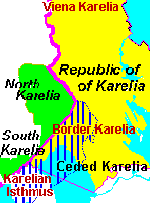
Geographic definitions
of Karelia
The border dividing and defining Karelia has also many meanings. It has been historically changing, and each change has influenced the movements of population. Especially the southern part of the Karelian Border has moved during centuries according to changing balance of power.The changes of the border have been illustrated on the set of maps that are available on the right (Picture set 2).
The Swedish Empire was extending its regime towards east, untill early 1600's. During this movement the protestant forces pushed out supporters of Bysantic faith and settled the land with supporters of their own. For examle, Swedish kings colonised the land south of the Neva river with Finnish peasants. This "ingen mans land" (no man's land) is later known as Ingria. When the Russia was unified and became powerfull, it in turn, pushed the border step by step and treaty by treaty towards west, untill in 1809 all of Finland was separated from Sweden and put under the reign of Russian emperors as an autonomous Grand Duchy.
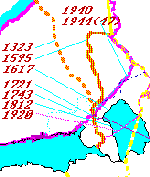
Changing borders
in Karelia
Images as Social Constructions
Images are here understood as socially created and shared definitions that mix facts and emotions. They are tied with narratives of the common past and desired future. They mobilise feelings of solidarity and they are used to mobilise people for action. Often they are proposals, sometimes seductive ones, to share a cultural or a political identity.This presentation is focused on the social and historical background of such images of Karelia. The border, either past or present, is an important element in the life-cycle of these images. The discussions about Karelia is organised into six images, originating on both sides of the border. This set starts, in chronological order, with two archetypal national images, that connect and place Karelia into ideas about Finland and Russia. The second pair of images have got their power from the great upheavals of the 20th century Europe, and the last images place Karelia into the frame of Soviet and Russian economic integration and today's new processes of cross-border co-operation. In that sence they represent ideas about the economic future of Karelia.
Archetypes of nationalist ideas
1. Origin of Finnish culture and landscape
2. Karelia as Russian NorthSocio-political drama in the 20th Century
3. Karelia, the promised land
4. Karelia, the lost landEconomic futures
5. The Paper Mill of Russia
6. Model of cross-border co-operation
The creation of the Finnish national identity and Finnish national culture found some of its fundamental elements in Karelia. During the flourishing Golden Age of Finnish arts, the National Romanticism was inspired by Kalevala, Karelia, and its landscape. The movement, later called Karelianism, included famous composers, painters, and writers (Sibelius, Edelfelt, Gallen-Kallela, Leino, to mention a few). The painters depicted the Finnish national landscape as the hilly and rough wild forests of eastern Finland and Karelia.
1. Origin of Finnish culture and landscapeElias Lönnrot, the country doctor who wrote down the traditional songs and edited them into Kalevala, collected the poems primarily in eastern Finland and Karelia.
The forests and the rough landscape of Karelia is felt to be the national landscape, the real and original Finnish nature. Those acting for the protection of Finnish nature, see Karelia as a place where the original Finnish nature has been preserved. Pentti Linkola, a Finnish fundamentalist green thinker and writer, wrote after a visit to the eastern side of the border: "I am trying define why our eastern border is the most amazing one on this globe: hell on this side and the paradise on the other."
Another example is the petition in support of the forest environment in Finland that in 1988 was signed by about 220,000 people. The symbol of the campaign was a black woodpecker. The figure was a reproduction of a painting by a Karelianist artist, Akseli Gallen-Kallela who in 1892 painted the original black woodpecker in the landscape of Paanajärvi, today in northern Russian Karelia. Thus the contemporary forest environments are being protected under the banner of the old Karelian forest.
The use of marginal areas as building blocks of national identity was not a unique Finnish feature. The romantic quest for identities looked often for frontiers, remote and peripheral places with authentic traditional cultures.
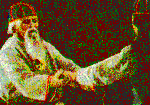
Singing of Kalevala
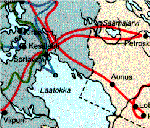
Routes of Lönnrot
collecting poems of Kalevala
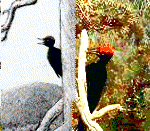
Woodpecker in 1988 and 1892
On the Russian side of the border, the traditional culture and the northern landscape of Karelia are joined into the Russian national image of the Russian North. The harsh but rich nature and ethnic cultures inspire northern arts. Russian North is beautiful wooden architecture, buildings with soul.
2. Karelia as Russian NorthNorth is rough nature and people with rich culture, it is the wild frontier “dikij sever”. Russian North has ethnic national groups with cultures of their own, Kalevala is included.
The life in the taiga has taught people to take care of themselves, and not trusting the Emperor or the Central Committee.
The rulers have used the North as a place of expulsion. Karelia has been the Siberia nearest to Moscow. Prison labour was used in the 1930s to build the canal from the White Sea to Lake Onega.
Kaleva is included
The importance of Kalevala as a source of identity, is so important that in addition to being a cornerstone of Finnisg identity, it is also identified as one part of the identity of Russian Karelia, as well. Kalevala has been printed (in Finnish) in Petrozavodsk. There are well-known painters who have illustrated Kalevala. There are editions where selected poems of Kalevala are printed in Finnish, in Russia and In English, with illustrations of Russian Karelian artists.On the right, one may compare an illustration of a Kaleva scene by a famous Finnish painter Akseli Gallen-Kallela (1891) and by a Russian painter Boris Akbulatov (1992). In this scene a fair maiden Aino is courted by the "old and mighty Väinämöinen".
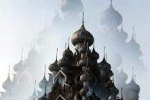
Wooden church of Kizhi
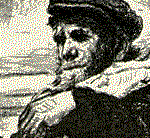
Stronk: Fisherman (1958)
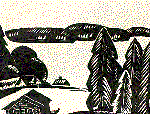
My home village Röhö
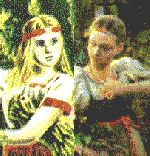
Pictures of Kalevala heroes are painted on both sides of border
After the civil war in Finland the Red leaders fled to the Soviet Union. One of their leaders, Edward Gylling, proposed to Lenin that a workers' socialist commune be established in eastern Karelia. The Workers' Commune of Karelia was established in June 1920. It became a haven for Finnish Red rebels, and later also for economic and political migrants. In the early 1930s thousands of Finns who had earlier migrated to North America moved to Soviet Karelia to build a workers' society. During the Depression many workers fled to Russian Karelia to find work. This group was later called deserters (loikkarit).
3. Karelia, the promised landFinns played an important part in the leadership of Karelia in the 1920s and the 1930s. The American and Canadian Finns were also influential in the economic and cultural life of Karelia. Many of them brought new technology, tools, machinery, and skills that they used, for example, to modernise forestry. The American Finns were singularly essential in founding Finnish-language cultural institutions, such as the theatre.
During Stalin's purges these Finnish elements were regarded as unreliable nationalists and imprisoned; many were killed or disappeared in the forced-labour camps of the Russian North.
Karelia remained a source of Finnish language material for leftists in Finland. In the 1970s, during the revival of leftist youth movements in the West, the Finnish leftists enthusiastically subscribed to the newspaper Neuvosto-Karjala (Soviet Karelia) and the cultural monthly Punalippu (Red Flag). Petrozavodsk was sending radio broadcasts in Finnish and publishing Finnish translations of Marxist books. Alongside the story of Che Guevara, Finnish radical youth read a book about Toivo Antikainen, a romantic Red guerilla-hero of the northern taiga. For more down-to-earth workers the Finnish newspaper and cultural journals were a Finnish language window to Soviet socialism.
After the fall of the Soviet Union the political images of the Cold War period are losing their attraction. The Finnish newspaper Neuvosto-Karjala (Soviet Karelia) has changed its name to Karjalan Sanomat (Karelian News) and the cultural journal Punalippu (Red Flag) continues as Carelia; the bulk of their subscribers still live on the Finnish side of the border. The cultural journal Carelia has also published some short stories and poetry in the Karelian language but the main language of these publications is Finnish.
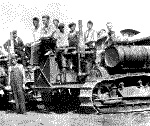
Many of the heroic workers in Matrocy logging centre in the 1930's were Finns.
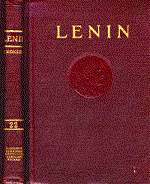
Lenin's Works were printed in Finnish in Petrozavodsk
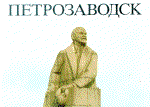
Soviet Karelia Newspaper was a Finnish language window to Socialism
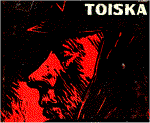
Finnish-born author Uljas Wickström wrote about a Finnish guerilla hero who fought against white Finns in Karelian forests
After the Second World War the borderline was moved westwards and about 420,000 evacuees from ceded territories in Karelia were resettled in other parts of Finland. Into the areas annexed by the Soviet Union new inhabitants were transferred from Russia, Byelorussia and other parts of the Soviet Union.
4. Karelia, the lost landLarge parts of these areas of Karelia were part of a border zone that was closed to the general public. Although officially friendly bilateral relationships developed between the states of the Soviet Union and Finland, the border of the Cold War separated the evacuated Karelians from their earlier homeland.
The resettling of the Karelian evacuees in Finland was a huge national effort, and the assimilation of the Karelians into Finnish society was a long, and sometimes, painful process. Because a large number of the Karelians had been farmers, they were given new farms in Finland. A few decades later they and their children experienced a dramatic structural change in Finnish agriculture and again participated in a large migration, this time from small farms to towns and factories in the south.
The common experience of the evacuees created a special identity for Finnish Karelians, and the core of this identity has been the image of Karelia as the lost land. In the post-war political life of Finland, the issue of settling the Karelians and later the fate of their small farms have received a great deal of attention, and there have been many influential spokesmen for the Karelians in several political parties.
The sustained cultural impact of these events has been the longing for Karelia, the lost land. The common language of all the migrants and refugees is the culture of nostalgia, and the image of Karelia as a lost land has taken on a symbolic value.
Harry Martinson, a world-famous Swedish author, included in his famous saga "Aniara" (first published in 1956) a "Song of Karelia" (Sång om Karelen). Aniara is an epic poem about the last human beings, who after having escaped from the destroyed planet Earth have spent several generations in a spaceship seeking a new home planet. "Song of Karelia" uses elements from Kalevala (the maiden Aino, summer lake, cuckoo bird, birches, white nights) and translates Karelia into a symbol of a general human longing for lost roots.
The image of Karelia as the lost land, has also lost its political power to mobilize, since the number of surviving Karelian evacuees is diminishing. However the cultural and symbolic significance is still strong. The national organization of Karelians (the Karelian Association) is an influential organization, maintaining cultural identity, arranging large summer meetings, and since the early 1990s' also organizing trips for Karelians to see their earlier home places. It has also tried to raise the political issue of returning the lost parts of Karelia to Finland. This idea may attract some spontaneous speculation about the proper location of the border in the popular imagination, but it does not, however, have much support among the serious political parties.
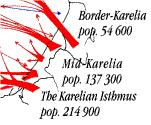
Patterns of resettling the evacuees from Karelia
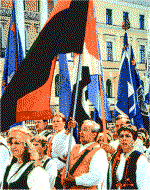
Karelian Associations keep on marching
Song of Karelia
Harry Martinson
After the Second World War, on the Soviet side of the border, Karelia was seeking its role in the construction of socialism. In the geographic division of labour of the Soviet Union it became a location for a territorial forestry-industrial complex that specialised in cutting timber and producing pulp and paper.
5. The paper mill of RussiaAfter the War large numbers of workers were transported to the forestry centres in Karelia. Over 300 new forestry villages were founded, a forest tractor factory was established in Petrozavodsk, pulp and paper factories were built, and the training of forestry engineers began at Petrozavodsk State University.
During the Soviet era all forestry companies, wood processing and transport of wood in the Karelian Republic was centralised into one huge state company Karellesprom. At the end of 1980s employed over 91,000 workers and included more than 60 different production units.
In the Soviet division of labour Karelia produced newsprint (40 percent of the Russian demand), cellulose, a high percentage of paper bags, pulp and paper machinery, forestry tractors. In return it imported energy (oil), all kinds of foodstuffs, even fodder for livestock from other parts of the Soviet Union.

The economic role of forestry related industries in Russian Karelia

Map of the Forest Industry Places in Russian Karelia

Karelia produced forestry tractors of its own
Soviet system of forestry is based on effictive final cuttings.
After the fall of the Iron Curtain the possibility of cross-border co-operation has changed the development perspectives of the two Karelian peripheries on the opposite sides of the borderline. The regional authorities on both sides have tried to increase their voices in the decisions concerning border area development and co-operation.
6. Model of Cross-border Co-operationThe Karelian Republic, which is a subject of the Russian Federation, has gained some rights to engage in foreign relations with its neighbours and control the tax revenues collected in the region. On the Finnish side the regional councils of the counties are implementing national and European Union structural and regional policy programmes. Joint committees are working on priorities and projects. Initiatives are being made to the central administrations, for example, to build infrastructures and institutions supporting cross-border co-operation.
EuRegio Karelia
The newest initiative is the EuRegio Karelia, which is an area formed by three Regional councils of Finland (Kainuu, Northern Karelia and Northern Ostrobothnia) and the Republic of Karelia of the Russian Federation.The area of the Finnish part of the Euregio is one fourth of the total area of Finland, but only 12% of population of the whole country live there. About 750 km of the common border between Russia and Finland (total length is 1300 km) belong to the territory of Euregio Karelia.
The Program "Our common border 2001-2006" is based on two programs "The program of cross-border co-operation of the Republic of Karelia for 2001-2006"and "Interreg-IIIA- Karelia 2000-2006". This program is the basis for co-operation within the framework of Euregio Karelia. According to the European experts' opinion this is a unique document in its way, because there is no similar examples either in European Union or in Russia. One of the objectives of this program is to present to European Union common approach of the Finland's and Russian Federation's border regions to problems facing in cross-border co-operation and to transfer decision-making powers on Tacis/CBC projects to the regional level.
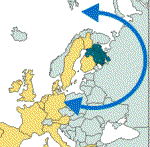
Map of EuRegio Karelia
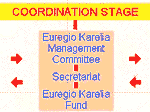
Co-operation Model of EuRegio Karelia
The six social definitions of Karelia presented here are not fully independent of one another, nor are they equal in importance.
Reproduction of the Images of KareliaIn today's new initiatives for cross border politics, the last image has the most intensive connections to the visions and plans of different social actors. The image of vibrant borderland with emerging cross-border processes is utilising some of the earlier images. Particularly suitable for recycling are the images of the ethnic culture and northern landscape. They can be used for developing tourism, one the most important priorities of future joint activities.
Also the idea of the forest mill of Russia, has practical relevance, because the forest resources of Karelia, and of the larger North-western Russia as well, have become the basis for the co-operation of forest sector enterprises, forest experts and researchers on both sides of the border. The statistics on the import of roundwood from Russia to Finland have grown to record making figures, and Russians are interested in the new forestry technology and concepts of silviculture developed in the Nordic Countries.
Today the image of the Russian North is also contradictory. The exploitation of northern resources (oil, forests, minerals) has aroused conflicts over issues of ownership, environment, and the needs of global and local development. On the other hand, the wilderness and regional cultures are exploited in attracting tourists: bus tours, river cruises in hotel boats, hunting and fishing parties in the wilderness. In Russia as well, the ethnic cultures of the north are utilized when regional identities are constructed and future roles negotiated in the Russian Federation. The fate and the form of regionalization is one of the major dimensions defining the different future scenarios of the Russian Federation.
The image of Karelia as the lost land, has also lost its power to mobilize. However, the leaders of the Karelian Association have repeatedly tried to raise the political issue of returning the lost parts of Karelia to Finland. This idea may attract some spontaneous speculation about the proper location of the border in the popular imagination, but it does not, however, have much support among the established political parties. The return of the ceded areas (even by leasing them) has not been regarded as realistic or feasible. In addition, many of those who have felt that the loss of those areas was wrong, understand that the wrongs of history cannot be corrected by committing new ones. The image of a vibrant borderland of cooperation is offering a more attractive future than poor reruns of the dramas of the past.
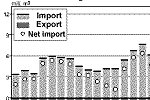
The Finnish imports of raw wood increase.
Updated numbers 1970 - 2005.